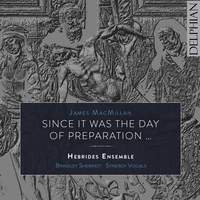Recording of the Week,
James MacMillan's new work on the Resurrection
A new work from James MacMillan is always worth sitting up and taking notice of. He’s one of today’s most successful composers, and his last few works (for instance his recent Luke Passion) have been critically acclaimed. While Passion settings are fairly common, few composers have paid much attention to what comes after the Crucifixion – the Resurrection and Jesus’ subsequent appearances to his disciples. This is MacMillan’s subject matter – picking up immediately where the Passion left off.

The idea of a work that “merges old and new” is one of the most tired clichés in the classical music world, but Since it was the day of Preparation… really does. Its instrumentation – for cello, clarinet, horn, harp and theorbo, accompanying a single-voice vocal quartet and a bass soloist – immediately suggests a kind of contemporary version of a broken consort. And indeed, before any text is set we hear the first of what MacMillan calls “motets” for the solo instruments – here it is the theorbo that is featured, very much in Dowlandian mode and not the last time that the spirit of the Renaissance will come to the fore in the work. These “motets” function similarly to the chorales in Bach’s Passions – meditations on the plot. Each instrumentalist has one to themselves, and MacMillan has clearly invested significant time in discussing with the players what their instruments are capable of, as the writing is always idiomatic and shows the players’ abilities off well.
Two paragraphs in and I haven’t mentioned anything about the singing yet! But, in my defence, this is very much a “chamber oratorio” in which all the players are equal participants. With such a small ensemble, each instrumentalist is a soloist – just as the vocalists are. Macmillan rejects the traditional format of one constant Evangelist – the narration is first taken by the tenor, then by the baritone, and subsequently by duets or trios singing homophonically. They sing in a style that seems natural and eternal when one hears it, despite being completely new – a fusion of Gregorian chant and MacMillan’s Scottish-inflected, ornamented idiom, which (to the best of my knowledge) is something he’s never done before.
As so often, I lack the space to describe all the great things about this piece. One highlight that I really have to mention, though, is the first of the three Interludes for the instrumental quintet – a meditation on Jesus’ burial that begins in beautiful melancholy before becoming more agitated. Fitting five such different instruments together harmoniously must have been an incredibly difficult task, but MacMillan’s writing shows no hint of it – it’s as natural as if this were a well-established chamber ensemble like the wind quintet or string quartet.
Part II (the oratorio is in three sections) sees English and Latin texts juxtaposed as Peter and John discover the empty tomb and Mary meets Jesus in the garden. The English, driving on the action, is always more prominent – the Latin seems to be more in the role of interjections. The writing is characteristic MacMillan – full of rhythmic vitality, angular and excitable, contrasting strongly with the meditative chant of Part I.
More links to the past follow – a quartet section evoking the polyphony of the Renaissance motet, and then a nod to Bach’s use of the “halo” (shadowing the recitative with held string chords for those sections of his Passions where Jesus speaks). MacMillan, though, goes beyond the serenity of sustained strings – his “halo” is composed of gently jingling handbells, played by the singers while Brindley Sherratt takes on the role of Christus with quiet assurance.
The closing instrumental Postlude – following a passage in which St John, too, bemoans his own lack of space to write down everything he wants to say – reprises the haunting wistfulness of the first Interlude, gradually fading out onto a lingering unison A.
What else need be said? This is an incredible piece, and I firmly believe it’s destined to become one of MacMillan’s most-performed works.
Brindley Sherratt (bass), Hebrides Ensemble, Synergy Vocals
Available Formats: CD, MP3, FLAC, Hi-Res FLAC



